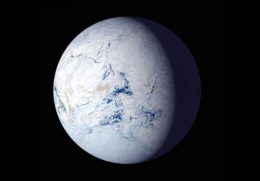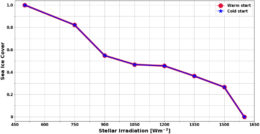The Earth likely underwent several periods of planet-wide ice coverage in the past, in what’s known as snowball Earth events. A new study explores whether snowball events are also a risk for tidally locked, habitable exoplanets.
An Icy Fate

Current theory suggests that the Earth underwent several snowball events in its past history. [NASA]
Under some conditions, this runaway snowball effect can lead to a fully icy world that’s no longer able to defrost itself, even if incoming stellar light returns to original levels.

Artist’s impression of a cold, tidally-locked planet. Ice covers much of the planet’s surface, but the point directly facing the planet’s host star remains ice-free. [NASA/JPL-Caltech]
Looking Beyond Our Solar System
The paradigm described above depends on specifics of how heat is transferred in the atmosphere of a rapidly rotating planet like Earth. But in searching for habitable planets beyond our solar system, we might wonder whether other types of worlds also experience snowball events.
In particular, the majority of the potentially habitable planets we’ve discovered lie around dim M-dwarf stars, and many of these planets are tidally locked, meaning the same side of the planet faces its host star at all times. Can worlds like this snowball, too?
To investigate this question, a team of scientists led by Jade Checlair (University of Chicago) used an atmospheric global climate model to conduct simulations of a tidally locked, Earth-sized planet that circles its M-dwarf host on a 50-day orbit. In particular, the team was curious whether heat transfer within a global ocean would affect the outcome — so they covered their simulated planet in a multi-layer ocean that reached a depth of 189 meters.
No Snowballs

The authors’ results show that sea-ice coverage follows a smooth relationship with stellar irradiation on tidally locked planets: for each level of stellar irradiation, the planet equilibrates to the same final state regardless of where it started. This is not the case on planets with runaway snowball events. [Checlair et al. 2019]
This means that for a tidally locked planet in its star’s habitable zone, snowball states should not be possible for extended periods of time. If a planet were to experience a catastrophic event like a volcanic eruption or asteroid impact, it may ice over briefly. But the stellar radiation concentrated on the side of the planet facing its host would quickly cause the planet to warm back up again and return to its original state.
Good or Bad?
Is the lack of tendency for tidally locked planets to snowball a good thing or a bad thing? Though a global ice age could wipe out preexisting complex life, it’s also possible that snowball events could help drive life to evolve more rapidly, by providing evolutionary pressure to adapt. The jury’s still out on the impact of snowball events, but now we know a bit more about where to expect them!
Citation
“No Snowball on Habitable Tidally Locked Planets with a Dynamic Ocean,” Jade H. Checlair et al 2019 ApJL 884 L46. doi:10.3847/2041-8213/ab487d

1 Comment
Pingback: 自転速度が遅い太陽系外惑星では「スノーボールアース」状態が長続きしない? - sorae 宇宙へのポータルサイト